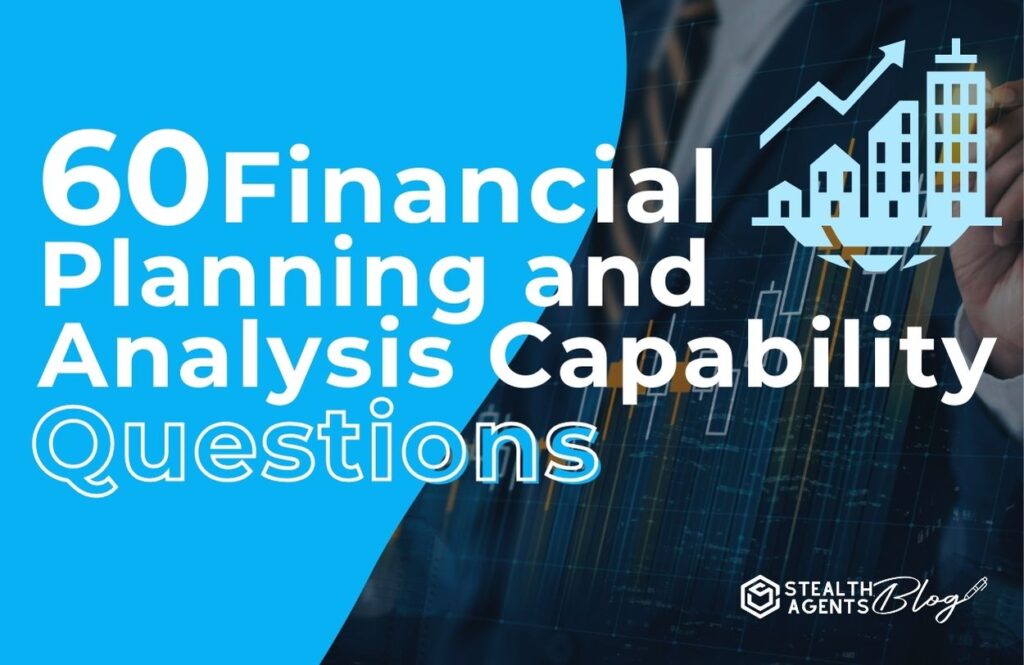In the constantly shifting landscape of finance, staying afloat doesn’t cut it; you’ve got to sail ahead. As the wind of change ushers in new financial practices, you need a sturdy mast to catch and ride the innovation wave. But how do you know if your financial planning and analysis (FP&A) is seaworthy?
Let’s dive into 60 crucial questions that will help you navigate your financial compass with assurance.
To ensure your financial strategy is robust and comprehensive, we’ve compiled a checklist that includes not only key FP&A questions but also essential Business Disaster Recovery Planning questions. These questions will help you prepare for and navigate through unexpected challenges, ensuring your business remains resilient and adaptable.
The importance of Financial Planning and Analysis
Imagine FP&A as your financial GPS, guiding you on the most efficient route to your company’s long-term financial objectives. What sets thriving businesses apart from those merely treading water is a deliberate and calculated approach to financial planning.
Gone are the days of relying on hunches and gut feelings; FP&A brings scientific precision that can mean the difference between profit and peril.
Without further ado, here are 60 financial planning and analysis questions to revolutionize your approach to business finance.
For more insights on structuring your organization effectively, check out our guide on the chain of command in business.
The List: 60 Financial Planning and Analysis Capability Questions
- Does your financial forecast look beyond a year?
- A forecast must be a forward-looking tool. Does yours accommodate multi-year projections, giving leadership a long-term strategic financial perspective?
- Can your FP&A process adapt to major economic shifts?
- Thinking ahead is one thing, but can your FP&A swiftly reshape plans when economic tsunamis hit? Flexibility is key.
- To what extent do you conduct “What If” analyses?
- Is your FP&A capable of running different scenarios to assess potential outcomes for strategic decisions?
- How accurate have your past financial forecasts been?
- Track record matters. Is your past forecasting reliably quantifiable and a basis for current and future planning?
- What’s the lead time for your forecasting process?
- Speed to insight is crucial. Can your process keep up with the pace of change in your industry or is it bogged down in bureaucracy?
- Are your Key Performance Indicators (KPIs) aligned with your strategic objectives?
- Your KPIs should serve as the lighthouse, guiding your business. Are they still relevant and reflective of your long-term strategy?
- Are you leveraging sophisticated FP&A software?
- The right tools can make your journey far smoother. Is your tech stack cutting-edge, aiding in efficient analysis and reporting?
- How integrated is your FP&A data with other business functions?
- Data silos are akin to having a hole in the boat. Is your data seamlessly integrated, informing decisions across your organization?
- Can your financial model adequately account for the impact of inflation and interest rates?
- These are the skulking sea monsters of finance. Does your model have inflation and interest rate swim lanes to predict their impact?
- Do you have a formal process to update your financial forecast regularly?
- Like weather updates for your voyage, regular forecast updates are critical. Is this embedded in your finance team’s routine?
- Is your reporting process steered towards actionable insights?
- Navigational feedback from your journey leads to actionable insights. Are your reports rich in insights that lead to strategic decisions?
- How does your FP&A procedure account for risks and uncertainties?
- Sailing is not without risk. Can your FP&A methodology adequately identify, assess, and plan for financial risks?
- Does your finance team have a seat at the strategic planning table?
- The crew needs a voice in the ship’s direction. Does your finance team’s input directly influence strategic planning discussions?
- To what extent does your FP&A process rely on automation?
- Automation can be the wind in your sails. Does your FP&A take advantage of automated processes to reduce manual labor and error?
- Do you have scenario planning for M&A or partnership ventures?
- The course change for M&A and partnerships can be tumultuous. Do you have clear financial scenarios to aid these strategic decisions?
- Is your budgeting process participatory or centralized?
- A participatory process ensures all hands are on deck. Is your budget built with input from across the business, or is it a top-down affair?
- How well do you communicate financial information to non-finance stakeholders?
- Clear communication is essential, especially across different departments. Does your financial communication resonate with stakeholder perspectives?
- Are you utilizing rolling forecasts for a more agile financial approach?
- Is your FP&A capable of updating and refreshing the forecast regularly to maintain a dynamic outlook on future financial performance?
- How closely do you monitor actuals versus plan, and why?
- Keeping a vigilant watch on your ship’s path is crucial. What methods do you have in place to monitor and analyze variances, and how do these inform course corrections?
- Does your FP&A process foster a culture of continuous improvement?
- A good captain always seeks to refine their journey. Does your FP&A encourage a culture of learning and enhancement?
- Do you factor in technological advancements into your FP&A capabilities?
- Technology is the winds of change for the modern financial journey. Are you embracing and incorporating advancements into your FP&A?
- How often do you revise cost assumptions and drivers?
- Your sails need the right wind – costs must be regularly adjusted. What is your process for reviewing and updating cost inputs to maintain a realistic forecast?
- Do you have a formalized process for ad hoc analysis requests?
- Sometimes the voyage calls for sidesteps. How does your FP&A team handle ad hoc analysis requests while keeping the ship on course?
- Is your FP&A team structured to facilitate quick turnarounds on requests?
- Quick reflexes save you the storm’s swell. Is your team structured and agile enough to provide fast responses to urgent analysis needs?
- How does your FP&A process align with corporate governance requirements?
- The compass of accountability points north. Does your FP&A align with regulatory and corporate governance requirements?
- Are your expense forecasts granular enough to be actionable?
- A captain needs to know what cargo to cut in a storm. Are your expense forecasts detailed enough to support reallocation decisions?
- Do you evaluate the accuracy of your forecast models on a regular basis?
- Have you cast a critical eye on the maps of your forecasts? Regular evaluations are key. How do you assess and improve the accuracy of your models?
- How does your FP&A process balance short-term performance with long-term objectives?
- The wind is fickle – balancing short gains with long-term objectives is an art. How does your FP&A process manage this equilibrium?
- Do you tie financial performance to employee incentives?
- The crew is often galvanized by a share of the bounty. Do your incentive structures align with financial performance objectives?
- To what extent does your FP&A process forecast cash flow variations?
- Smooth seas rarely make skilled sailors – forecasting cash flow swings is vital. How comprehensive is your process in this regard?
- Does your FP&A capability extend to tax planning and analysis?
- Taxation is a substantial iceberg in the way of earnings. Does your FP&A process include tax planning and analysis capabilities?
- How does your FP&A process accommodate different time horizons for different business segments?
- The voyage on each segment may vary in time and turbulence. How does your FP&A accommodate these different time scopes for various business segments?
- Are you leveraging predictive analysis and machine learning in your FP&A?
- The telescope of tomorrow is predictive analysis and machine learning. Are you steering towards these technologies for your financial forecasts?
- Is real-time financial analysis and reporting part of your FP&A repertoire?
- The stars you navigate by should reflect the current reality. Is your FP&A capable of real-time analysis and reporting, or is it lagging behind?
- How do you account for seasonality in your FP&A process?
- Some ports are busy only at certain times. How does your FP&A process adjust for seasonal impacts on your business?
- Do you embrace and budget for emergent trends and market shifts?
- Sighting the new land requires readiness, not just its discovery. Do you budget and plan for emergent trends and shifts in your market?
- How closely does your FP&A process tie into your continuous planning methodology?
- Finances and planning should be as entwined as rope and net. Does your FP&A process align closely with your continuous planning methodology?
- What is your process for evaluating and adopting new FP&A tools and methodologies?
- Ships rot without the right maintenance and materials. How do you evaluate and adopt new FP&A tools and methodologies to ensure your capability doesn’t erode?
- Are you regularly educating and training your finance team on FP&A best practices?
- The crew needs steady hands. Regular training keeps your team sharp. How are you educating and training your finance team on FP&A best practices?
- Do you engage directly with C-Suite executives to provide strategic financial counsel?
- The chain of command needs a strong link between finance and strategy. Do you engage directly with C-suite executives, providing strategic financial counsel?
- Is your FP&A process capable of managing and forecasting various currencies?
- Different currencies mark different coastlines. Can your FP&A handle and forecast different currencies effectively?
- Are you prepared for legislative and regulatory changes impacting finance?
- The legal edicts can change the rules of navigation. Are you prepared for future legislative and regulatory changes that may impact finance operations?
- Do you have a process for tracking and evaluating the economic impact of geopolitical events?
- Storms don’t only brew at sea. Do you have a formal process for tracking and evaluating the economic impact of geopolitical events?
- Are your financial models sensitive to the impact of climate risk and sustainability initiatives?
- The seas are warming. Are your financial models flexible enough to account for climate risk and sustainability initiatives?
- How do you balance the complexity of your FP&A process with the need for simplicity?
- Nautical charts are complex, but your compass should be simple. How do you balance the need for a robust FP&A process with the need for simplicity?
- Do you have cross-functional teams to address complex financial challenges and opportunities?
- When a ship is at stake, all hands are needed. Do you have cross-functional teams ready to address complex financial challenges and opportunities?
- Do you conduct post-mortem analysis to learn from major financial shifts and decisions?
- After the dust has settled, the ledger should speak volumes. Do you conduct post-mortem analysis to learn from major financial shifts and decisions?
- How well does your FP&A process align with industry best practices and benchmarks?
- The stars for comparison are not your own. To what extent does your FP&A process align with industry best practices and benchmarks?
- Do you have a formal change management process for when you need to update core FP&A processes?
- The sea is ever-changing, and so should your processes. Do you have a formal change management process in place when updating core FP&A processes?
- What is your process for identifying and capitalizing on new growth opportunities?
- New shores beckon, and businesses need to be ready to set sail. What is your process for identifying and capitalizing on new growth opportunities?
- What validation checks do you have in place for ensuring the accuracy of your financial data?
- Accurate maps are worth more than gold. What validation checks do you have in place to ensure the accuracy of your financial data?
- Do you have a formal process for stakeholder consultation in the FP&A process?
- A map that all agree on often leads to smoother sailing. Do you have a formal process for stakeholder consultation in your FP&A process?
- To what extent does your FP&A process incorporate employee feedback and insights?
- The crew sometimes knows the waters better than the captain. To what extent does your FP&A process incorporate employee feedback and insights?
- How do you account for the resources used and time spent on the FP&A process itself?
- Sailing a well-crafted ship takes resources and time. How do you account for the resources used and time spent on your FP&A process?
- Are you proactively managing and forecasting working capital and liquidity?
- Running aground due to illiquidity is avoidable. Are you proactively managing and forecasting working capital and liquidity?
- How do you evaluate and integrate the latest industry trends into your FP&A process?
- The latest industry trends re-draw the coastline. How do you evaluate and integrate these trends into your FP&A process?
- Do you have a process for benchmarking against competitors and market leaders?
- The sea of competition should not be uncharted. Do you have a process for benchmarking against competitors and market leaders?
- What kind of dashboards and visualizations do you use to aid in decision-making?
- A plain sea can obscure dangers. What kind of dashboards and visualizations do you use to aid in decision-making?
- How do you ensure the confidentiality and security of your financial data and FP&A processes?
- A breach can sink your ship. How do you ensure the confidentiality and security of your financial data and FP&A processes?
- What is your process for implementing insights and recommendations derived from your FP&A analysis?
- Maps alone don’t change the course. What is your process for implementing insights and recommendations derived from your FP&A analysis?
Conclusion
As we charter these 60 questions, we’ve mapped a comprehensive course around the importance of financial planning and analysis in your business. Each inquiry is a buoy in the water, guiding you to chart a course that is strategic, informed, and positioned for success in the tempestuous seas of modern finance.
Forge ahead, leverage these questions to steer your business to prosperity. Remember, the aim is not just to reach the horizon but to lead the fleet. Happy sailing!









